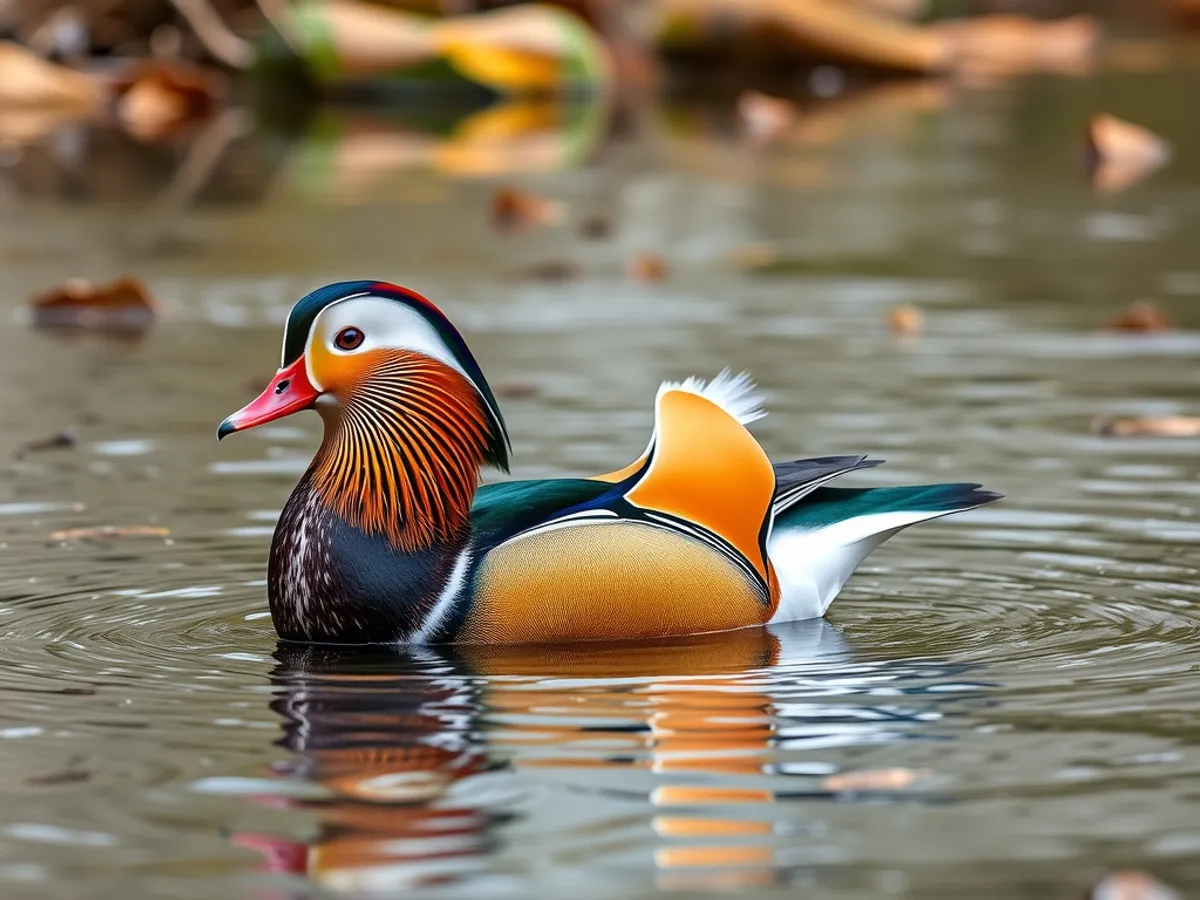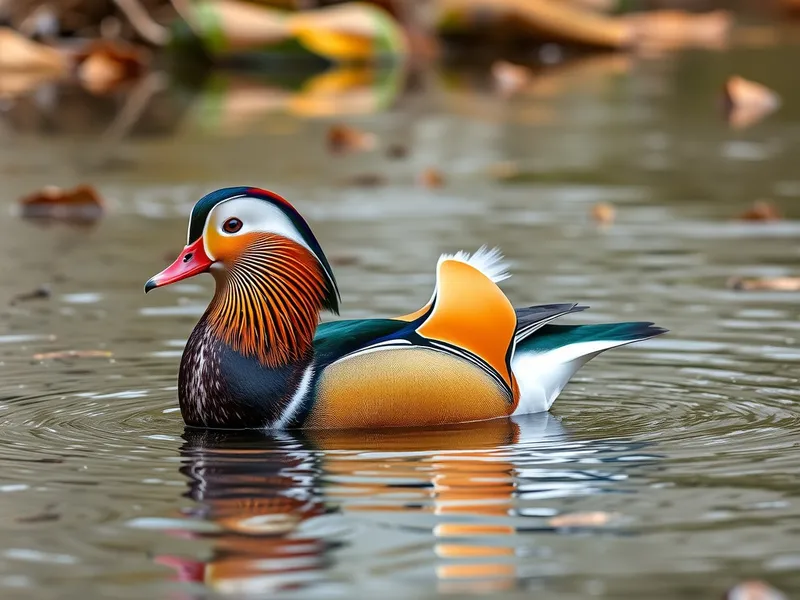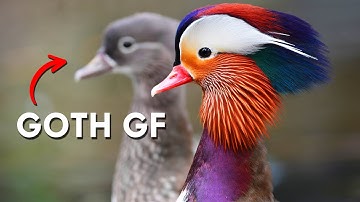
Mandarin Duck
Aix galericulata

Meet the Mandarin Duck
The Mandarin Duck is a strikingly beautiful medium-sized perching duck native to East Asia, renowned for the male's ornate, multicolored plumage featuring vivid orange sails, a purple breast, and striking white facial markings. Females are more subtly colored, with mottled gray and brown feathers and a distinctive white eye ring. Mandarin Ducks inhabit wooded ponds, slow-moving rivers, and lakes, often nesting in tree cavities near water. They are highly social, especially outside the breeding season, and are known for their strong pair bonds. While their native populations in China and Russia are declining, feral populations thrive in parts of Europe due to escapes from captivity.
Classification
Bird
Habitat
Wooded ponds, slow-moving rivers, and lakes near forests
Diet
Omnivore
Lifespan
6-10 years
Conservation
Least Concern
Weight
0.5-0.7 kg
📖Fascinating Facts
Spectacular Plumage
The male Mandarin Duck is considered one of the world's most beautiful ducks, sporting vibrant orange, blue, and purple feathers during the breeding season.
Tree Nester
Unlike many other ducks, Mandarin Ducks often nest in tree cavities, sometimes several meters above the ground.
Symbol of Love
Mandarin Ducks are revered in Chinese, Japanese, and Korean cultures as symbols of marital fidelity and lifelong partnership.
📋Detailed Description
The Mandarin Duck (Aix galericulata) is a medium-sized perching duck, measuring 41–49 cm (16–19 in) in length and weighing between 430–690 g (15–24 oz), with a wingspan of 65–75 cm (26–30 in). Males are instantly recognizable by their ornate plumage: a striking combination of iridescent green, purple, and bronze on the head, a reddish face with bold white crescents above the eyes, and prominent orange 'sails'—elongated tertial feathers that rise vertically over the back. The bill is pinkish-red, and the legs and feet are orange. Females are more cryptically colored, with a gray-brown body, white-speckled breast, and a distinct white eye-ring with a trailing stripe. Both sexes have short tails and broad wings adapted for rapid takeoff from water or perches. Mandarin Ducks are agile flyers and strong swimmers, frequently perching in trees thanks to their sharp claws. Their vocalizations include soft whistles and low quacks, with males producing a distinctive high-pitched 'whee' call during courtship. The species is highly arboreal outside of feeding, often roosting and nesting in tree cavities. Mandarin Ducks are primarily crepuscular, being most active at dawn and dusk. Their social structure is flexible: while they form monogamous pairs during the breeding season, they may gather in flocks of up to several hundred individuals outside this period, especially at favored roosting or feeding sites.
💡 Did you know?
After hatching, ducklings leap from their tree nest to the ground, sometimes from heights of over 10 meters, without injury.
🔬Research & Sources
Wikipedia Summary
The mandarin duck is a perching duck species native to the East Palearctic. It is sexually dimorphic - the males are elaborately coloured, while the females have more subdued colors. It is a medium-sized duck, at 41–49 cm (16–19 in) long with a 65–75 cm (26–30 in) wingspan. It is closely related to the North American wood duck, the only other member of the genus Aix. 'Aix' is an Ancient Greek word which was used by Aristotle to refer to an unknown diving bird, and 'galericulata' is the Latin for a wig, derived from galerum, a cap or bonnet. Outside of its native range, the mandarin duck has a large introduced population in the British Isles and Western Europe, with additional smaller introductions in North America.
Last Modified: 5/22/2025
🎭Behavior & Social Structure
Mandarin Ducks exhibit complex social behaviors, particularly during the breeding season when males perform elaborate courtship displays involving head-bobbing, wing-flashing, and vocalizations to attract females. Outside the breeding season, they are gregarious and may form large flocks, often mixing with other duck species. Feeding is typically done by dabbling at the water's surface or foraging on land for seeds, acorns, aquatic plants, insects, snails, and small fish. They are adept at climbing and perching in trees, a rare trait among ducks, and will often rest on branches overhanging water. Mandarin Ducks are generally shy and wary of humans in their native range, but feral populations in Europe have become more habituated. Daily routines involve periods of feeding interspersed with preening, resting, and social interactions. They are known to migrate short distances in response to seasonal changes, particularly in northern parts of their range.
👶Reproduction & Life Cycle
Mandarin Ducks are seasonally monogamous, forming strong pair bonds that may persist for several years. Courtship begins in late winter, with nesting occurring from April to June. Females select tree cavities—often 1–10 meters above ground—near water for nesting, sometimes using old woodpecker holes or nest boxes. Clutch size ranges from 9 to 12 eggs, which are creamy white and measure about 49 x 36 mm. The female incubates the eggs alone for 28–30 days, during which the male remains nearby to guard the territory. After hatching, ducklings leave the nest within 24–48 hours, leaping from the cavity to the ground or water below, guided by the mother's calls. The female leads the brood to water, where she provides protection and guidance, but the ducklings feed themselves. Fledging occurs at around 40–45 days. Breeding success is closely tied to the availability of suitable nesting sites and undisturbed habitats.
🛡️Adaptations & Survival
Mandarin Ducks possess several unique adaptations for their arboreal lifestyle. Their strong, sharp claws enable them to perch and nest in trees, a trait uncommon among ducks. The cryptic coloration of females and ducklings provides effective camouflage against predators, especially during nesting and brooding. The male's vibrant plumage serves as a sexual signal during courtship but is molted after the breeding season in favor of a more subdued 'eclipse' plumage for better concealment. Their broad wings and lightweight bodies facilitate agile flight through dense woodland and rapid escape from predators. Behavioral adaptations include synchronized flock movements and the use of alarm calls to warn conspecifics of danger. Their omnivorous diet allows them to exploit a wide range of food resources, contributing to their success in both native and introduced habitats.
🎨Cultural Significance
The Mandarin Duck holds significant cultural and symbolic value in East Asia, especially in China, Korea, and Japan. It is revered as a symbol of fidelity, love, and marital harmony due to its perceived lifelong pair bonds. Mandarin Duck imagery is commonly featured in art, literature, and wedding gifts, and pairs of duck figurines are often given to newlyweds to bless their union. In Chinese folklore, they are known as 'yuanyang' (鸳鸯), representing conjugal affection. The species is also celebrated in Japanese poetry and paintings, and it appears in Korean proverbs and traditional crafts. In the West, the Mandarin Duck's striking appearance has made it a popular ornamental species in aviculture and public parks.
🔬Recent Research & Discoveries
Recent genetic studies have clarified the close evolutionary relationship between the Mandarin Duck and the North American Wood Duck (Aix sponsa), the only other member of the genus Aix. Research into their reproductive ecology has highlighted the importance of cavity-nesting behavior and the impact of nest site competition on breeding success. Studies of introduced populations in Europe have provided insights into their adaptability, dispersal patterns, and potential ecological impacts, including limited hybridization with native duck species. Ongoing research is examining the effects of urbanization and climate change on migratory behavior and population dynamics. There is also growing interest in the role of Mandarin Ducks as bioindicators of forest and wetland health.
🎥Wildlife Videos

Mandarin Ducks: A Mesmerizing Tale of Nature's Most Exquisite Pair | documentary film
Mandarin Ducks: A Mesmerizing Tale of Nature's Most Exquisite Pair Dive into the enchanting world of Mandarin Ducks in this ...
Visual Wonders HD

15 Most Beautiful Ducks On The Planet | Wildlife Documentary | BBTV Official
When you think of beautiful birds, ducks might not be the first that come to mind—but prepare to be amazed. Across the world's ...
BBTV Official

The Magical World of Mandarin Ducks: Nature’s Living Rainbows.
Explore the mesmerizing world of Mandarin ducks, nature's living rainbows! Learn about their dazzling feathers, unique behaviors ...
Kids' Wisdom Tales

Mandarin duck || Animal Planet
Mandarin duck || Animal Planet || BBC Earth || Wildlife Explore the Wild: Amazing Wildlife Animals in Their Natural Habitat ...
Discover Animals

Behind Every Mandarin Duck Drake Is A Goth GF
----------- SOCIAL MEDIA https://www.tiktok.com/@animalogic https://www.instagram.com/animalogicshow/ ...
Animalogic

Mandarin Ducks: A Closer Look at Nature's Painted Pair
Mandarin Ducks: A Journey Through Time and Tradition | Nature Documentary Dive into the enchanting world of Mandarin Ducks ...
Close to Nature
🌍Habitat Information
The Mandarin Duck typically inhabits Wooded ponds, slow-moving rivers, and lakes near forests environments. Mandarin Ducks have adapted to their environments with specialized features and behaviors.
Primary Habitat:
Wooded ponds, slow-moving rivers, and lakes near forests
More detailed habitat information will be available soon.
🛡️Conservation Status
The Mandarin Duck is currently classified as Least Concern. Conservation efforts are crucial for preserving this species for future generations.
Common Threats:
- 🏠Habitat loss and fragmentation
- 🌡️Climate change impacts
- 🎯Hunting and poaching
- 🏭Human-wildlife conflict
⚠️Threats & Conservation Challenges
In their native range, Mandarin Ducks face threats from habitat loss due to deforestation, wetland drainage, and urban development. Illegal hunting and egg collection have also contributed to population declines, particularly in China and Russia. Competition for nesting sites with invasive species such as the Common Starling (Sturnus vulgaris) and predation by mammals (e.g., raccoon dogs, martens) and birds of prey pose additional challenges. Despite these pressures, global populations are considered stable, largely due to successful introductions and feral populations in Europe and Japan. Climate change and increasing human disturbance remain long-term concerns. Conservation efforts focus on habitat protection, the provision of nest boxes, and monitoring of both native and introduced populations.
🔬Scientific Classification
Scientific Name
Aix galericulata
Classification Hierarchy
🔍 About Taxonomic Classification
Taxonomic classification is a hierarchical system used by scientists to classify and organize living organisms based on shared characteristics and evolutionary relationships.
The system moves from broad categories (Kingdom) to increasingly specific ones, with each animal's scientific name typically consisting of its Genus and species.
📝Community Notes
Share your observations and insights about the Mandarin Duck with our community of wildlife enthusiasts.
Join Our Community
Sign in to share your observations and connect with fellow wildlife enthusiasts.
Sign In to ContributeNo community notes yet
Be the first to share your observations about the Mandarin Duck!
Explore Mandarin Duck
Select a tab above to learn more about this amazing animal.
📸Photo Gallery
No photos available for this animal yet.
🌟Discover More Wildlife
Continue your journey of discovery with more fascinating animals from our database
